LINKSYS WRT55AGV2 Wireless A+G Broadband Router User Manual Book
LINKSYS LLC Wireless A+G Broadband Router Book
LINKSYS >
Contents
- 1. Users Manual Part 1
- 2. Users Manual Part 2
- 3. Users Manual Part 3
Users Manual Part 1
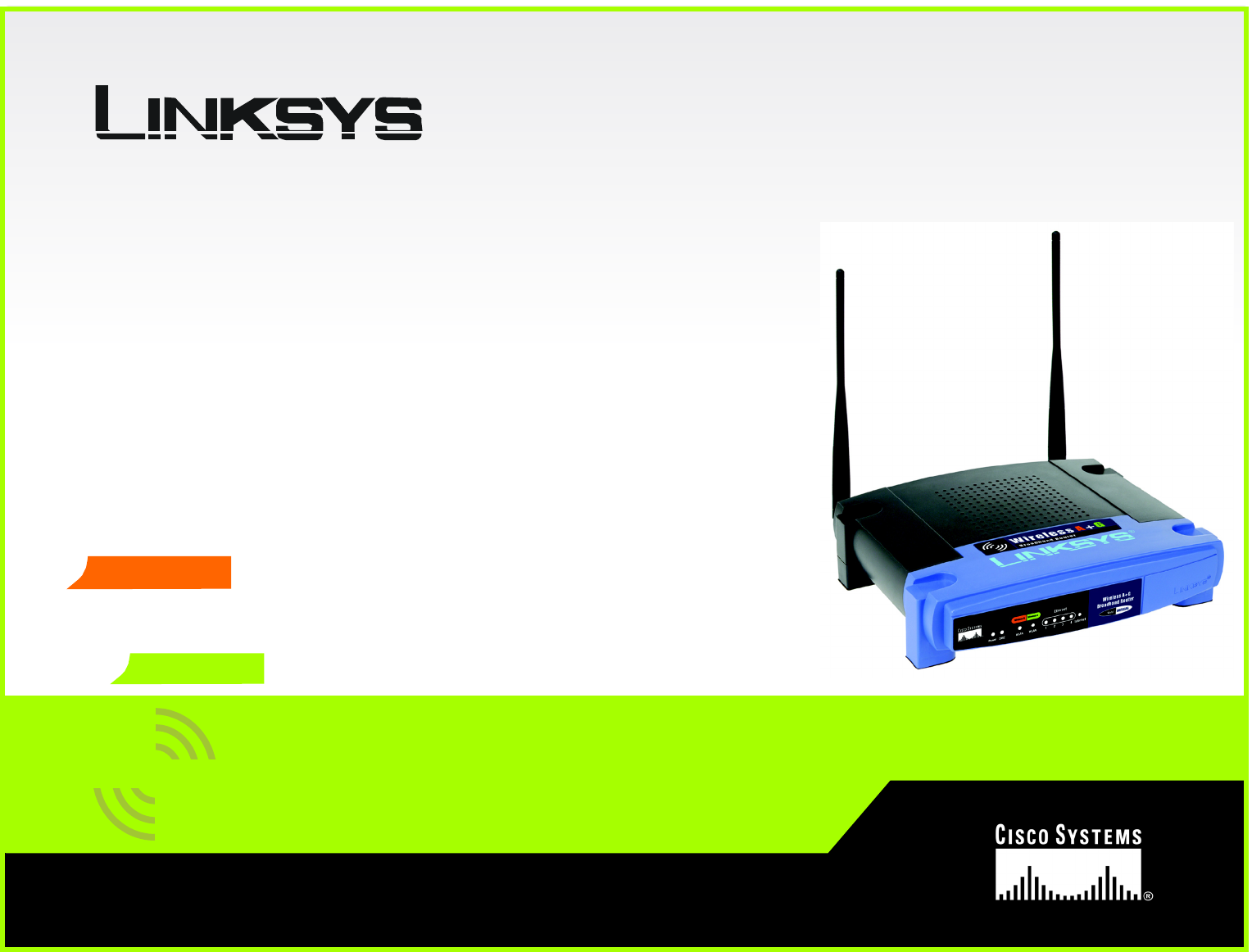
A Division of Cisco Systems, Inc.
®
Model No.
Broadband Router
Wireless A+G
WRT55AG ver. 2
User Guide
WIRELESS
Dual-Band
GHz
5
GHz
2.4
802.11g
802.11a
+
Dual-Band

Dual-Band Wireless A+G Broadband Router
Copyright and Trademarks
Specifications are subject to change without notice. Linksys is a registered trademark or trademark of Cisco
Systems, Inc. and/or its affiliates in the U.S. and certain other countries. Copyright © 2004 Cisco Systems, Inc. All
rights reserved. Other brands and product names are trademarks or registered trademarks of their respective
holders.
How to Use This User Guide
This User Guide has been designed to make understanding networking with the Dual-Band Wireless A+G
Broadband Router easier than ever. Look for the following items when reading this User Guide:
In addition to these symbols, there are definitions for technical terms that are presented like this:
Also, each figure (diagram, screenshot, or other image) is provided with a figure number and description, like
this:
Figure numbers and descriptions can also be found in the “List of Figures” section in the “Table of Contents”.
This exclamation point means there is a caution or warning
and is something that could damage your property or the
Dual-Band Wireless A+G Broadband Router.
This checkmark means there is a note of interest and is
something you should pay special attention to while using
the Dual-Band Wireless A+G Broadband Router.
This question mark provides you with a reminder about
something you might need to do while using the
Dual-Band Wireless A+G Broadband Router.
word: definition.
Figure 0-1: Sample Figure Description
WRT55AG_V2-UG-40913NC JL
WARNING: This product contains chemicals, including lead, known
to the State of California to cause cancer, and birth defects or other
reproductive harm. Wash hands after handling.

Dual-Band Wireless A+G Broadband Router
Table of Contents
Chapter 1: Introduction 1
Welcome 1
What’s in this Guide? 2
Chapter 2: Planning Your Wireless Network 4
Network Topology 4
Ad-Hoc versus Infrastructure Mode 4
Network Layout 4
Chapter 3: Getting to Know the Dual-Band Wireless A+G Broadband Router 6
The Back Panel 6
The Front Panel 7
Chapter 4: Connecting the Dual-Band Wireless A+G Broadband Router 8
Overview 8
Hardware Installation for Connection to Your Broadband Modem 8
Hardware Installation for Connection to Another Router 10
Chapter 5: Configuring the Dual-Band Wireless A+G Broadband Router 12
Overview 12
How to Access the Web-based Utility 13
The Setup Tab - Basic Setup 13
The Setup Tab - MAC Address Clone 17
The Wireless Tab - Basic Wireless Settings 18
The Wireless Tab - Wireless Security 20
The Wireless Tab - Wireless MAC Filter 22
The Wireless Tab - Advanced Wireless Settings 23
The Security Tab - Firewall 26
The Security Tab - VPN Passthrough 26
The Access Restrictions Tab - Internet Access Policy 27
The Applications and Gaming Tab - Port Range Forwarding 29
The Applications & Gaming Tab - Port Range Triggering 31
The Applications and Gaming Tab - DMZ 32
The Applications and Gaming Tab - QoS 33
The Administration Tab - Management 36
The Administration Tab - Log 38

Dual-Band Wireless A+G Broadband Router
The Administration Tab - Diagnostics 39
The Administration Tab - Factory Defaults 40
The Administration Tab - Firmware Upgrade 40
The Status Tab - Router 41
The Status Tab - Local Network 42
The Status Tab - Wireless 43
Appendix A: Troubleshooting 44
Common Problems and Solutions 44
Frequently Asked Questions 52
Appendix B: Wireless Security 59
Security Precautions 59
Security Threats Facing Wireless Networks 59
Appendix C: Upgrading Firmware 62
Appendix D: Windows Help 63
Appendix E: Finding the MAC Address and IP Address for Your
Ethernet Adapter 64
Windows 98SE or Me Instructions 64
Windows 2000 or XP Instructions 64
For the Router’s Web-based Utility 65
Appendix F: Glossary 66
Appendix G: Specifications 73
Appendix H: Warranty Information 74
Appendix I: Regulatory Information 75
Appendix J: Contact Information 77

Dual-Band Wireless A+G Broadband Router
List of Figures
Figure 3-1: The Router’s Back Panel 6
Figure 3-2: The Router’s Front Panel 7
Figure 4-1: Connecting Your Broadband Modem 8
Figure 4-2: Connecting Your Network Devices 9
Figure 4-3: Connecting the Power 9
Figure 4-4: Diagram for Connection to Another Router 10
Figure 4-5: Connecting Another Router 10
Figure 4-6: Connecting Your Network Devices 11
Figure 4-7: Connecting the Power 11
Figure 5-1: Router’s IP Address 13
Figure 5-2: Router Login Screen 13
Figure 5-3: Setup Tab - Basic Setup 13
Figure 5-4: Static IP Connection Type 14
Figure 5-5: PPPoE Connection Type 14
Figure 5-6: Static DHCP Client List 15
Figure 5-7: DHCP Client Table 15
Figure 5-8: Setup Tab - MAC Address Clone 17
Figure 5-9: Wireless Tab - Basic Wireless Settings 18
Figure 5-10: Wireless Tab - Wireless Security (Pre-Shared Key) 20
Figure 5-11: Wireless Tab - Wireless Security (Pre-Shared Key + RADIUS) 20
Figure 5-12: Wireless Tab - Wireless Security (WEP) 21
Figure 5-13: Wireless Tab - Wireless MAC Filter 22
Figure 5-14: Wireless Client List 22
Figure 5-15: Wireless Tab - Advanced Wireless Settings 23
Figure 5-16: Security Tab - Firewall 26
Figure 5-17: Security Tab - VPN Passthrough 26
Figure 5-18: Access Restrictions Tab - Internet Access Policy 27
Figure 5-19: Summary 27
Figure 5-20: List of PCs 28
Figure 5-21: Applications and Gaming Tab - Port Range Forwarding 29

Dual-Band Wireless A+G Broadband Router
Figure 5-22: Applications and Gaming Tab - Port Triggering 31
Figure 5-23: Applications and Gaming Tab - DMZ 32
Figure 5-24: Applications and Gaming Tab - QOS 33
Figure 5-25: Administration Tab - Management 36
Figure 5-26: Administration Tab - Log 38
Figure 5-27: Incoming Log 38
Figure 5-28: Outgoing Log 38
Figure 5-29: Administration Tab - Diagnostics 39
Figure 5-30: Ping 39
Figure 5-31: Administration Tab - Factory Defaults 40
Figure 5-32: Administration Tab - Firmware Upgrade 40
Figure 5-33: Status Tab - Router 41
Figure 5-34: Status Tab - Local Network 42
Figure 5-35: DHCP Client Table 42
Figure 5-36: Status Tab - Wireless 43
Figure C-1: Administration Tab - Firmware Upgrade 62
Figure E-1: IP Configuration Screen 64
Figure E-2: MAC Address/Adapter Address 64
Figure E-3: MAC Address/Physical Address 64
Figure E-4: Wireless MAC Filter List 65
Figure E-5: MAC Address Clone 65

1
Chapter 1: Introduction
Welcome
Dual-Band Wireless A+G Broadband Router
Chapter 1: Introduction
Welcome
Thank you for choosing the Linksys Dual-Band Wireless A+G Broadband Router. The Dual-Band Wireless A+G
Broadband Router will allow you to network wirelessly better than ever, sharing Internet access, files and fun,
easily and securely.
How does the Dual-Band Wireless A+G Broadband Router do all of this? A router is a device that allows access to
an Internet connection over a network. With the Dual-Band Wireless A+G Broadband Router, this access can be
shared over the four switched ports or via the wireless broadcast at either up to 11Mbps for Wireless-B or up to
54Mbps for Wireless-A and/or Wireless-G. In addition, the whole network is protected by NAT technology. For
wireless networking, you also have a choice of wireless security methods. Additional security features, as well as
configuration options, are accessible through the easy-to-use, browser-based utility.
But what does all of this mean?
Networks are useful tools for sharing computer resources. You can access one printer from different computers
and access data located on another computer's hard drive. Networks are even used for playing multiplayer video
games. So, networks are not only useful in homes and offices, they can also be fun.
PCs on a wired network create a LAN, or Local Area Network. They are connected with Ethernet cables, which is
why the network is called “wired”.
PCs equipped with wireless cards or adapters can communicate without cumbersome cables. By sharing the
same wireless settings, within their transmission radius, they form a wireless network. This is sometimes called
a WLAN, or Wireless Local Area Network. The Dual-Band Wireless A+G Broadband Router bridges wireless
networks of 802.11a, 802.11b, and 802.11g standards and wired networks, allowing them to communicate with
each other.
With your wired and wireless networks connected to each other and the Internet, you can now share files and
Internet access—and even play games. All the while, the Dual-Band Wireless A+G Broadband Router protects
your networks from unauthorized and unwelcome users.
Linksys recommends using the Setup CD-ROM for first-time installation of the Router. If you do not wish to run
the Setup Wizard on the Setup CD-ROM, then use the instructions in this Guide to help you connect the
Dual-Band Wireless A+G Broadband Router, set it up, and configure it to bridge your different networks. These
instructions should be all you need to get the most out of the Dual-Band Wireless A+G Broadband Router.
ethernet: an IEEE standard network protocol that
specifies how data is placed on and retrieved from
a common transmission medium.
lan (local area network): the computers and
networking products that make up the network
in your home or office.
802.11b: an IEEE wireless networking standard
that specifies a maximum data transfer rate of
11Mbps and an operating frequency of 2.4GHz.
802.11g: an IEEE wireless networking standard
that specifies a maximum data transfer rate of
54Mbps, an operating frequency of 2.4GHz, and
backward compatibility with 802.11b devices.
browser: an application program that
provides a way to look at and interact with all
the information on the World Wide Web.
mbps: one million bits per second; a unit of
measurement for data transmission.
nat (network address translation): NAT
technology translated IP addresses of a
local area network to a different IP address
for the Internet.
802.11a: an IEEE wireless networking standard
that specifies a maximum data transfer rate of
54Mbps and an operating frequency of 5GHz.

2
Chapter 1: Introduction
What’s in this Guide?
Dual-Band Wireless A+G Broadband Router
What’s in this Guide?
This user guide covers the steps for setting up and using the Dual-Band Wireless A+G Broadband Router.
• Chapter 1: Introduction
This chapter describes the Router’s applications and this User Guide.
• Chapter 2: Planning Your Wireless Network
This chapter describes the basics of wireless networking.
• Chapter 3: Getting to Know the Dual-Band Wireless A+G Broadband Router
This chapter describes the physical features of the Router.
• Chapter 4: Connecting the Dual-Band Wireless A+G Broadband Router
This chapter instructs you on how to connect the Router to your network.
• Chapter 5: Configuring the Dual-Band Wireless A+G Broadband Router
This chapter explains how to use the Web-Based Utility to configure the settings on the Dual-Band Wireless
A+G Broadband Router.
• Appendix A: Troubleshooting
This appendix describes some problems and solutions, as well as frequently asked questions, regarding
installation and use of the Dual-Band Wireless A+G Broadband Router.
• Appendix B: Wireless Security
This appendix explains the risks of wireless networking and some solutions to reduce the risks.
• Appendix C: Upgrading Firmware
This appendix instructs you on how to upgrade the firmware on the Router should you need to do so.
• Appendix D: Windows Help
This appendix describes how you can use Windows Help for instructions about networking, such as installing
the TCP/IP protocol.
• Appendix E: Finding the MAC Address and IP Address for your Ethernet Adapter.
This appendix describes how to find the MAC address for your computer’s Ethernet adapter so you can use
the MAC filtering and/or MAC address cloning feature of the Router.
• Appendix F: Glossary
This appendix gives a brief glossary of terms frequently used in networking.

3
Chapter 1: Introduction
What’s in this Guide?
Dual-Band Wireless A+G Broadband Router
• Appendix G: Specifications
This appendix provides the technical specifications for the Router.
• Appendix H: Warranty Information
This appendix supplies the warranty information for the Router.
• Appendix I: Regulatory Information
This appendix supplies the regulatory information regarding the Router.
• Appendix J: Contact Information
This appendix provides contact information for a variety of Linksys resources, including Technical Support.

4
Chapter 2: Planning Your Wireless Network
Network Topology
Dual-Band Wireless A+G Broadband Router
Chapter 2: Planning Your Wireless Network
Network Topology
A wireless local area network (WLAN) is exactly like a regular local area network (LAN), except that each
computer in the WLAN uses a wireless device to connect to the network. Computers in a WLAN share the same
frequency channel and SSID, which is an identification name shared by the wireless devices belonging to the
same wireless network.
Ad-Hoc versus Infrastructure Mode
Unlike wired networks, wireless networks have two different modes in which they may be set up: infrastructure
and ad-hoc. An infrastructure configuration is a WLAN and wired LAN communicating to each other through an
access point. An ad-hoc configuration is wireless-equipped computers communicating directly with each other.
Choosing between these two modes depends on whether or not the wireless network needs to share data or
peripherals with a wired network or not.
If the computers on the wireless network need to be accessible by a wired network or need to share a peripheral,
such as a printer, with the wired network computers, the wireless network should be set up in Infrastructure
mode. The basis of Infrastructure mode centers around a wireless router or an access point, such as the Dual-
Band Wireless A+G Broadband Router, which serves as the main point of communications in a wireless network.
The Router transmits data to PCs equipped with wireless network adapters, which can roam within a certain
radial range of the Router. You can arrange the Router and multiple access points to work in succession to
extend the roaming range, and you can set up your wireless network to communicate with your Ethernet
hardware as well.
If the wireless network is relatively small and needs to share resources only with the other computers on the
wireless network, then the Ad-Hoc mode can be used. Ad-Hoc mode allows computers equipped with wireless
transmitters and receivers to communicate directly with each other, eliminating the need for a wireless router or
access point. The drawback of this mode is that in Ad-Hoc mode, wireless-equipped computers are not able to
communicate with computers on a wired network. And, of course, communication between the wireless-
equipped computers is limited by the distance and interference directly between them.
Network Layout
The Dual-Band Wireless A+G Broadband Router has been specifically designed for use with your 802.11a,
802.11b, and 802.11g products. Now, products using these standards can communicate with each other.
infrastructure: a wireless network
that is bridged to a wired network via
an access point.
ssid: your wireless network’s name.
ad-hoc: a group of wireless devices
communicating directly to each other
(peer-to-peer) without the use of an
access point.
access point: a device that allows wireless-
equipped computers and other devices to
communicate with a wired network. Also used
to expand the range of a wireless network.
adapter: a device that adds
network functionality to your PC.
ethernet: IEEE standard network protocol that
specifies how data is placed on and retrieved
from a common transmission medium.
network: a series of computers or devices
connected for the purpose of data sharing,
storage, and/or transmission between users.

5
Chapter 2: Planning Your Wireless Network
Network Layout
Dual-Band Wireless A+G Broadband Router
The Dual-Band Wireless A+G Broadband Router is compatible with all 802.11a, 802.11b, and 802.11g adapters,
such as the Notebook Adapters (WPC55AG, WPC54G, WPC11) for your laptop computers, PCI Adapters
(WMP55AG, WMP54G, WMP11) for your desktop PCs, and USB Adapters (WUSB54G, WUSB11) when you want to
enjoy USB connectivity. The Router will also communicate with the Wireless PrintServer (WPS54GU2, WPS11) and
Wireless Ethernet Bridges (WET54G, WET11).
When you wish to connect your wireless network with your wired network, you can use the Dual-Band Wireless
A+G Broadband Router’s four LAN ports. To add more ports, any of the Dual-Band Wireless A+G Broadband
Router's LAN ports can be connected to any of Linksys's switches (such as the EZXS55W or EZXS88W).
With these, and many other, Linksys products, your networking options are limitless. Go to the Linksys website at
www.linksys.com for more information about products that work with the Dual-Band Wireless A+G Broadband
Router.
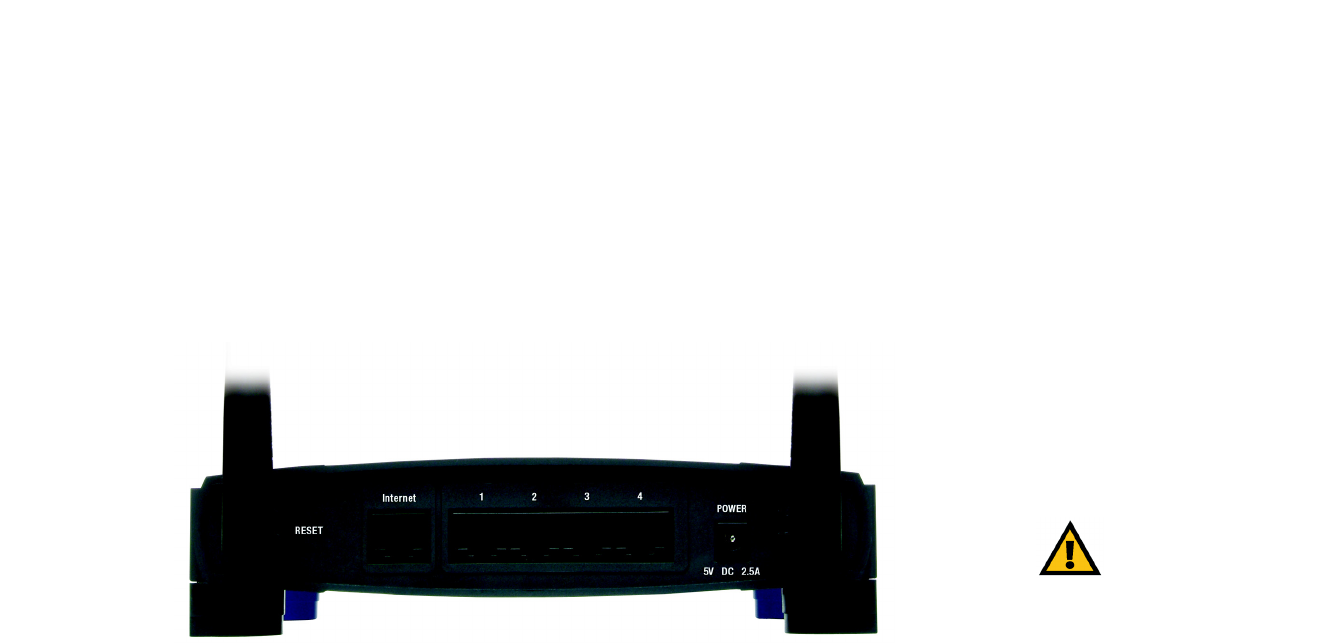
6
Chapter 3: Getting to Know the Dual-Band Wireless A+G Broadband Router
The Back Panel
Dual-Band Wireless A+G Broadband Router
Chapter 3: Getting to Know the Dual-Band Wireless A+G
Broadband Router
The Back Panel
The Router’s ports and Reset button are located on the back panel of the Router.
RESET Button There are two ways to reset the Router's factory defaults. Either press the RESET button, for
approximately five seconds, or restore the defaults from the Administration tab - Factory
Defaults in the Router's Web-based Utility.
Internet The Internet port is where you will connect your broadband Internet connection.
1, 2, 3, 4 These ports (1, 2, 3, 4) connect the Router to your networked PCs and other Ethernet network
devices.
POWER The POWER port is where you will connect the power adapter.
Figure 3-1: The Router’s Back Panel
IMPORTANT: If you reset the Router, all of
your settings, including Internet
connection, wireless, and security, will be
deleted and replaced with the factory
defaults. Do not reset the Router if you want
to retain these settings.
broadband: an always-on, fast Internet connection.
port: the connection point on a computer or networking
device used for plugging in cables or adapters.

7
Chapter 3: Getting to Know the Dual-Band Wireless A+G Broadband Router
The Front Panel
Dual-Band Wireless A+G Broadband Router
The Front Panel
The Router’s LEDs, which indicate the status of the Router and network activities, are located on the front panel.
Power Green. The Power LED lights up and will stay on while the Router is powered on. When the
Router goes through its self-diagnostic mode during every boot-up, this LED will flash. When
the diagnostic is complete, the LED will be solidly lit.
DMZ Green. The DMZ LED indicates when the DMZ function is being used. This LED will remain lit
as long as DMZ is enabled.
Wireless-A
WLAN Green. The WLAN LED flashes when there is a successful Wireless-A connection.
Wireless-G
WLAN Green. The WLAN LED flashes when there is a successful Wireless-G connection.
Ethernet
1, 2, 3, 4 Green. These numbered LEDs, corresponding with the numbered ports on the Router’s back
panel, serve two purposes. If the LED is continuously lit, the Router is successfully connected
to a device through that port. A flashing LED indicates network activity over that port.
Internet Green. The Internet LED lights up when there is a connection made through the Internet port.
Figure 3-2: The Router’s Front Panel

8
Chapter 4: Connecting the Dual-Band Wireless A+G Broadband Router
Overview
Dual-Band Wireless A+G Broadband Router
Chapter 4: Connecting the Dual-Band Wireless A+G
Broadband Router
Overview
Linksys recommends using the Setup Wizard on the Setup CD-ROM for first-time installation of the Router. For
advanced users, you may follow the instructions in this chapter, and then configure the Router through its Web-
based Utility (refer to “Chapter 5: Configuring the Dual-Band Wireless A+G Broadband Router”).
This chapter includes two sets of instructions. If the Dual-Band Wireless A+G Broadband Router will be the only
router in your network, follow the instructions in “Hardware Installation for Connection to Your Broadband
Modem.” If you want to install the Dual-Band Wireless A+G Broadband Router behind another router in your
network, then follow the instructions in “Hardware Installation for Connection to Another Router.”
Hardware Installation for Connection to Your Broadband Modem
1. Power down your network devices.
2. Locate an optimum location for the Router. The best place for the Router is usually at the center of your
wireless network, with line of sight to all of your wireless devices.
3. Adjust the antennas. Normally, the higher you place the antennas, the better the performance will be.
4. Using a standard Ethernet network cable, connect the Router’s Internet port to your broadband modem.
Figure 4-1: Connecting Your Broadband Modem
NOTE: For first-time installation of the Router,
Linksys recommends using the Setup Wizard on the
Setup CD-ROM.
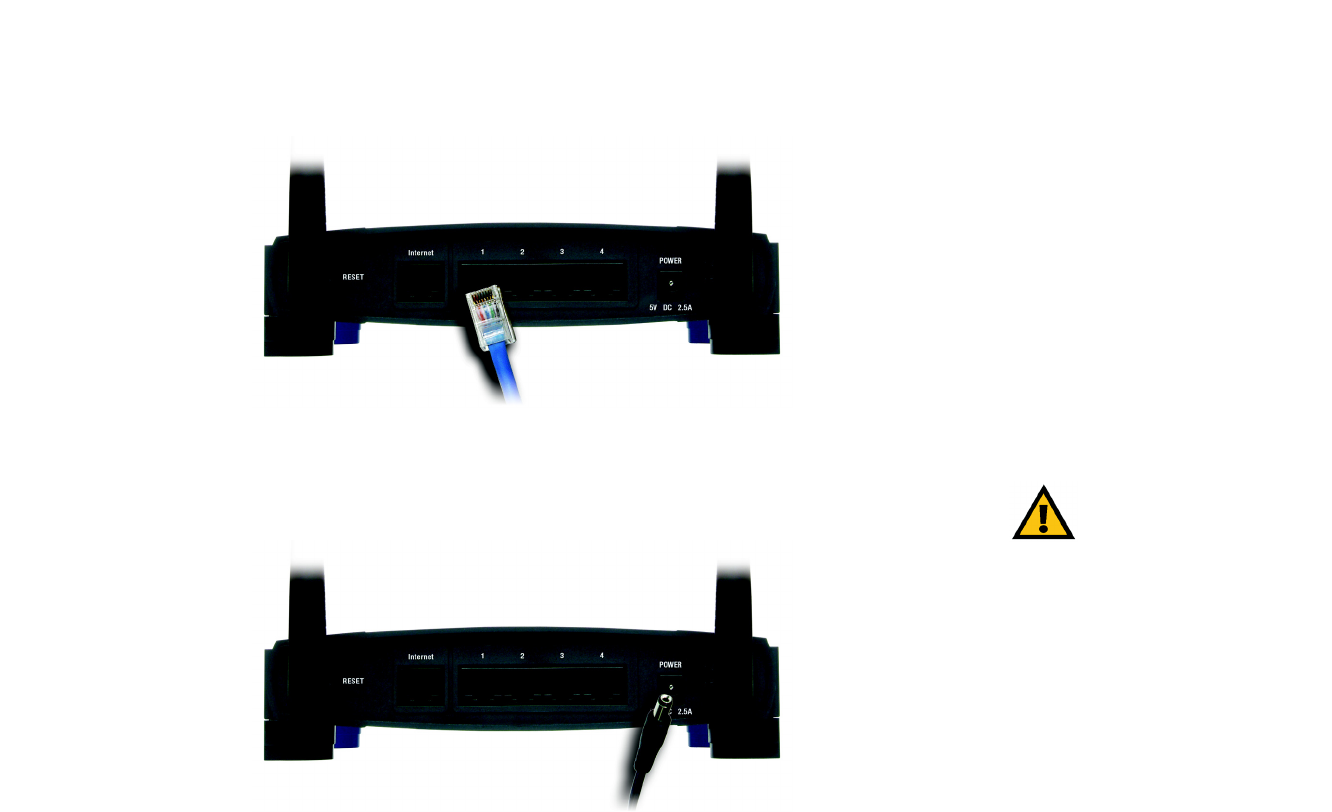
9
Chapter 4: Connecting the Dual-Band Wireless A+G Broadband Router
Hardware Installation for Connection to Your Broadband Modem
Dual-Band Wireless A+G Broadband Router
5. Connect your network PCs or Ethernet devices to the Router’s numbered ports using standard Ethernet
network cabling.
6. Connect the AC power adapter to the Router's Power port. Then connect the other end to an electrical outlet.
Only use the power adapter supplied with the Router. Use of a different adapter may cause product damage.
Now that the hardware installation is complete, proceed to “Chapter 5: Configuring the Dual-Band
Wireless A+G Router.”
Figure 4-2: Connecting Your Network Devices
Figure 4-3: Connecting the Power
IMPORTANT: Make sure you use the power
adapter that is supplied with the Router. Use of a
different power adapter could damage the Router.
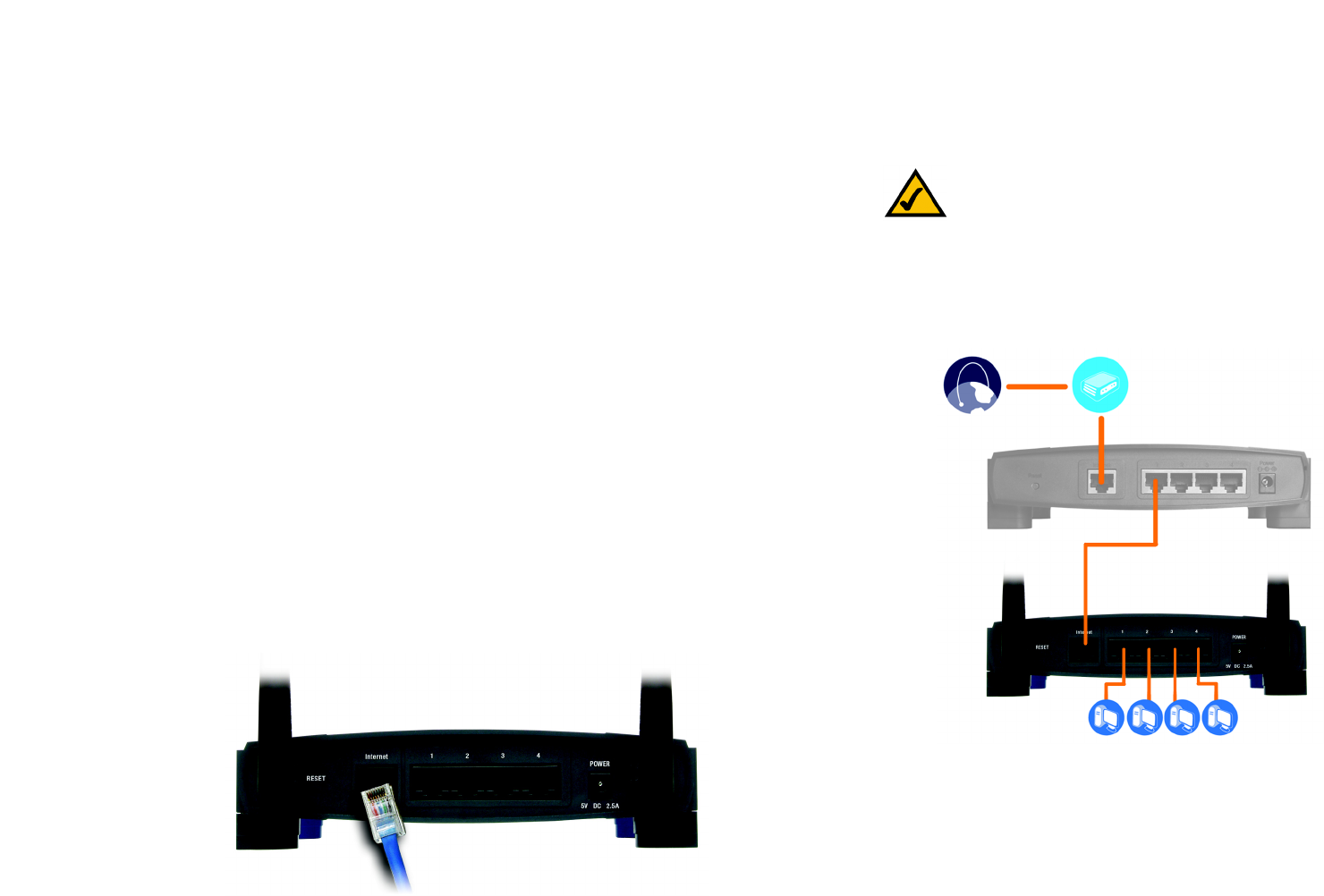
10
Chapter 4: Connecting the Dual-Band Wireless A+G Broadband Router
Hardware Installation for Connection to Another Router
Dual-Band Wireless A+G Broadband Router
Hardware Installation for Connection to Another Router
Before you install the Router, you must change the default IP address of the other router. This is mandatory
because both routers may be set to the same IP address by default. If you do not change the other router’s default
IP address, then you may not be able to set up the Router.
First, make sure the Router is NOT connected to your network. Then follow these instructions:
1. To access the other router’s Web-based Utility, launch Internet Explorer or Netscape Navigator, and enter the
other router’s default IP address, 192.168.1.1, in the Address field. Then press Enter.
2. A password request page will appear. Leave the User Name field blank. In the Password field, enter the
password you have set (the default password is admin). Then click the OK button.
3. The first screen that appears will display the Setup tab. In the Network Setup section, there is a setting called
Local IP Address (also called Router IP), which is set to 192.168.1.1. Change this to 192.168.2.1.
4. Click the Save Settings button to save your change, and then exit the Web-based Utility.
5. Power down your network devices. Now you will begin the hardware installation of the Router.
6. Locate an optimum location for the Router. The best place for the Router is usually at the center of your
wireless network, with line of sight to all of your wireless devices.
7. Adjust the antennas. Normally, the higher you place the antennas, the better the performance will be.
8. Connect a standard Ethernet network cable to the Router’s Internet port. Then, connect the other end of the
Ethernet cable to one of the numbered Ethernet ports on your other router.
Figure 4-4: Diagram for Connection to Another Router
NOTE: Steps 1-4 are instructions for a typical
Linksys router; however, if you are using a non-
Linksys router, refer to the other router’s
documentation for instructions on how to change its
local IP address to 192.168.2.1.
Internet Broadband
Modem
Router
Dual-Band
Wireless A+G
Broadband
Router
Figure 4-5: Connecting Another Router
Multiple PCs
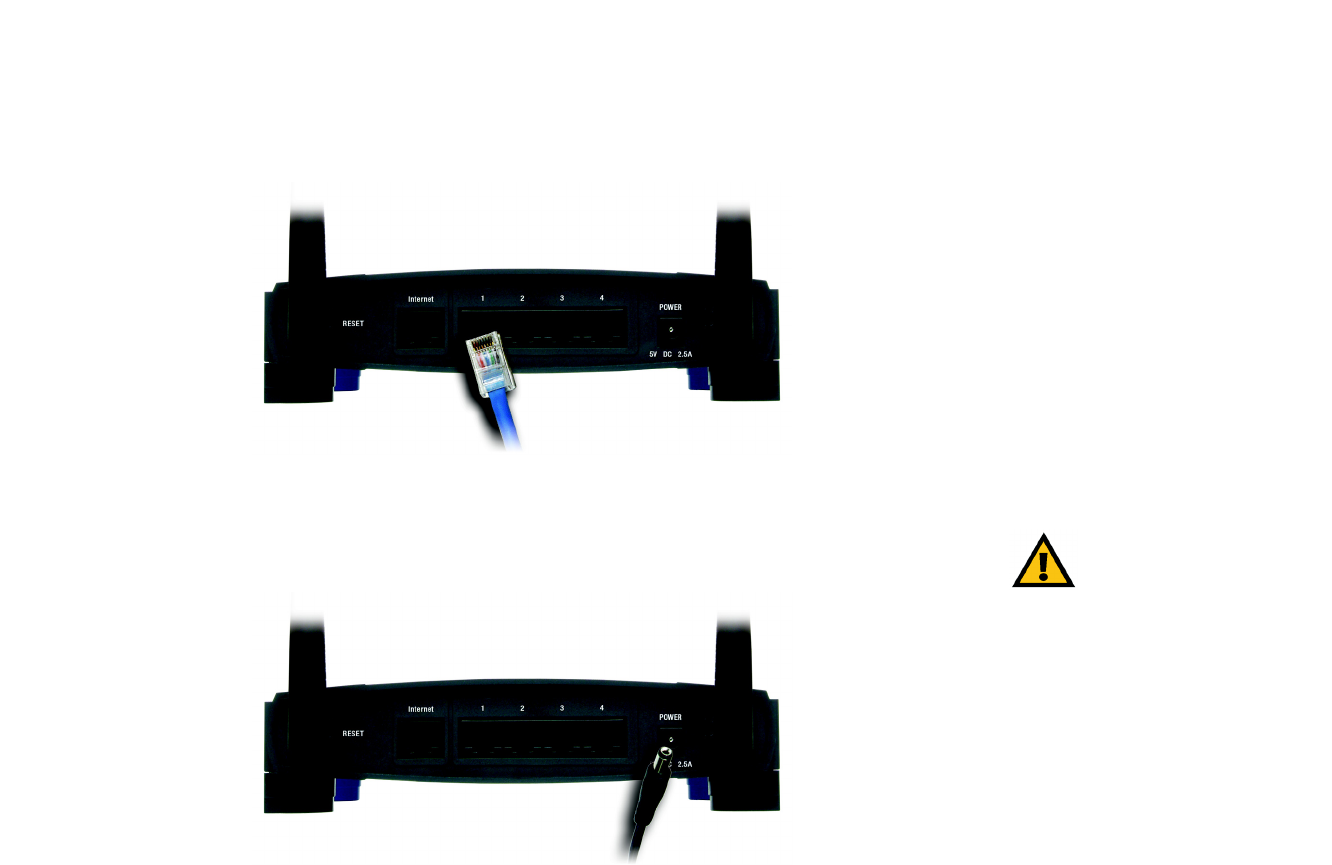
11
Chapter 4: Connecting the Dual-Band Wireless A+G Broadband Router
Hardware Installation for Connection to Another Router
Dual-Band Wireless A+G Broadband Router
9. Decide which network computers or Ethernet devices you want to connect to the Router.
Disconnect the selected computers or devices from the other router, and then connect them to the Router’s
numbered ports using standard Ethernet network cabling.
10. Connect the AC power adapter to the Router's Power port and the other end into an electrical outlet. Only use
the power adapter supplied with the Router. Use of a different adapter may result in product damage.
Now that the hardware installation is complete, proceed to “Chapter 5: Configuring the Dual-Band
Wireless A+G Router.”
Figure 4-6: Connecting Your Network Devices
Figure 4-7: Connecting the Power
IMPORTANT: Make sure you use the power
adapter that is supplied with the Router. Use of a
different power adapter could damage the Router.

12
Chapter 5: Configuring the Dual-Band Wireless A+G Broadband Router
Overview
Dual-Band Wireless A+G Broadband Router
Chapter 5: Configuring the Dual-Band Wireless A+G
Broadband Router
Overview
Linksys recommends using the Setup Wizard on the Setup CD-ROM for first-time installation of the Router. For
advanced users, you may follow the instructions in the previous chapter, “Chapter 4: Connecting the Dual-Band
Wireless A+G Broadband Router”, and then configure the Router through its Web-based Utility.
This chapter will describe each web page in the Utility and each page’s key functions. The utility can be accessed
via your web browser through use of a computer connected to the Router. For a basic network setup, most users
will use these two screens of the Utility:
• Basic Setup. On the Basic Setup screen, enter the settings provided by your ISP.
• Management. Click the Administration tab and then the Management tab. The Router’s default password is
admin. To secure the Router, change the Password from its default.
There are seven main tabs: Setup, Wireless, Security, Access Restrictions, Applications & Gaming, Administration,
and Status. Additional tabs will be available after you click one of the main tabs.
Make the necessary changes through the Web-based Utility. On each screen, click the Save Settings button to
apply your changes or Cancel Changes to cancel your changes. Help information is shown on the right-hand side
of the screen. For additional information, click More.
HAVE YOU: Enabled TCP/IP on your PCs? PCs
communicate over the network with this protocol.
Refer to “Appendix D: Windows Help” for more
information on TCP/IP.
NOTE: For first-time installation of the Router,
Linksys recommends using the Setup Wizard on the
Setup CD-ROM.
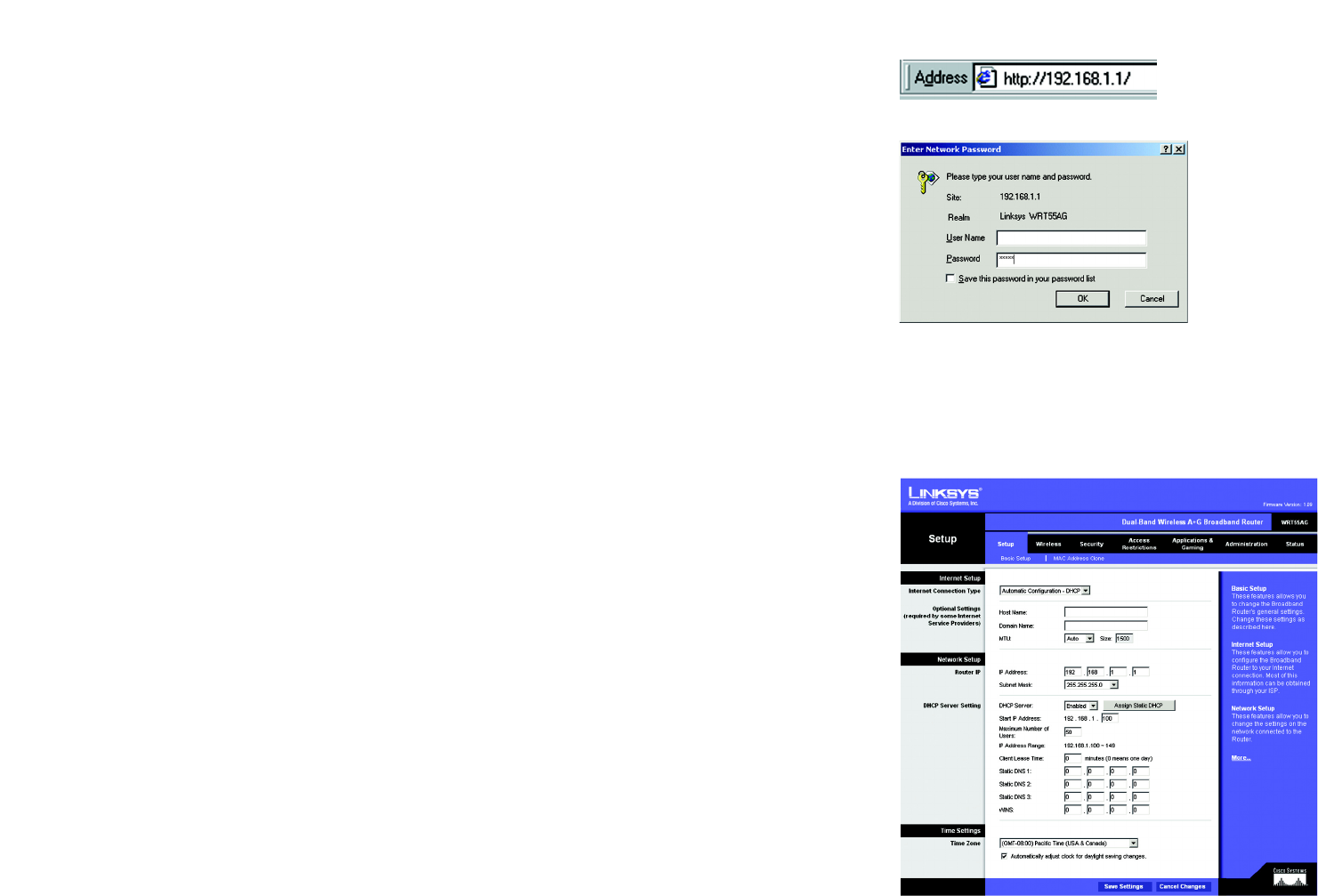
13
Chapter 5: Configuring the Dual-Band Wireless A+G Broadband Router
How to Access the Web-based Utility
Dual-Band Wireless A+G Broadband Router
How to Access the Web-based Utility
To access the Web-based Utility, launch Internet Explorer or Netscape Navigator, and enter the Router’s default IP
address, 192.168.1.1, in the Address field. Then press Enter.
A password request page will appear. Leave the User Name field blank. The first time you open the Web-based
Utility, use the default password admin. (You can set a new password from the Administration tab’s Management
screen.) Then click the OK button.
The Setup Tab - Basic Setup
The first screen that appears displays the Setup tab. This allows you to change the Router's general settings.
Internet Setup
The Internet Setup section configures the Router to your Internet connection. Most of this information can be
obtained from your ISP.
Internet Connection Type
Choose the type of Internet connection your ISP provides from the drop-down menu.
•Automatic Configuration - DHCP. By default, the Router’s Internet Connection Type is set to Automatic
Configuration - DHCP, which should be kept only if your ISP supports DHCP or you are connecting through a
dynamic IP address.
Figure 5-3: Setup Tab - Basic Setup
Figure 5-1: Router’s IP Address
Figure 5-2: Router Login Screen
ip (internet protocol): a protocol used to
send data over a network.
ip address: the address used to identify
a computer or device on a network.
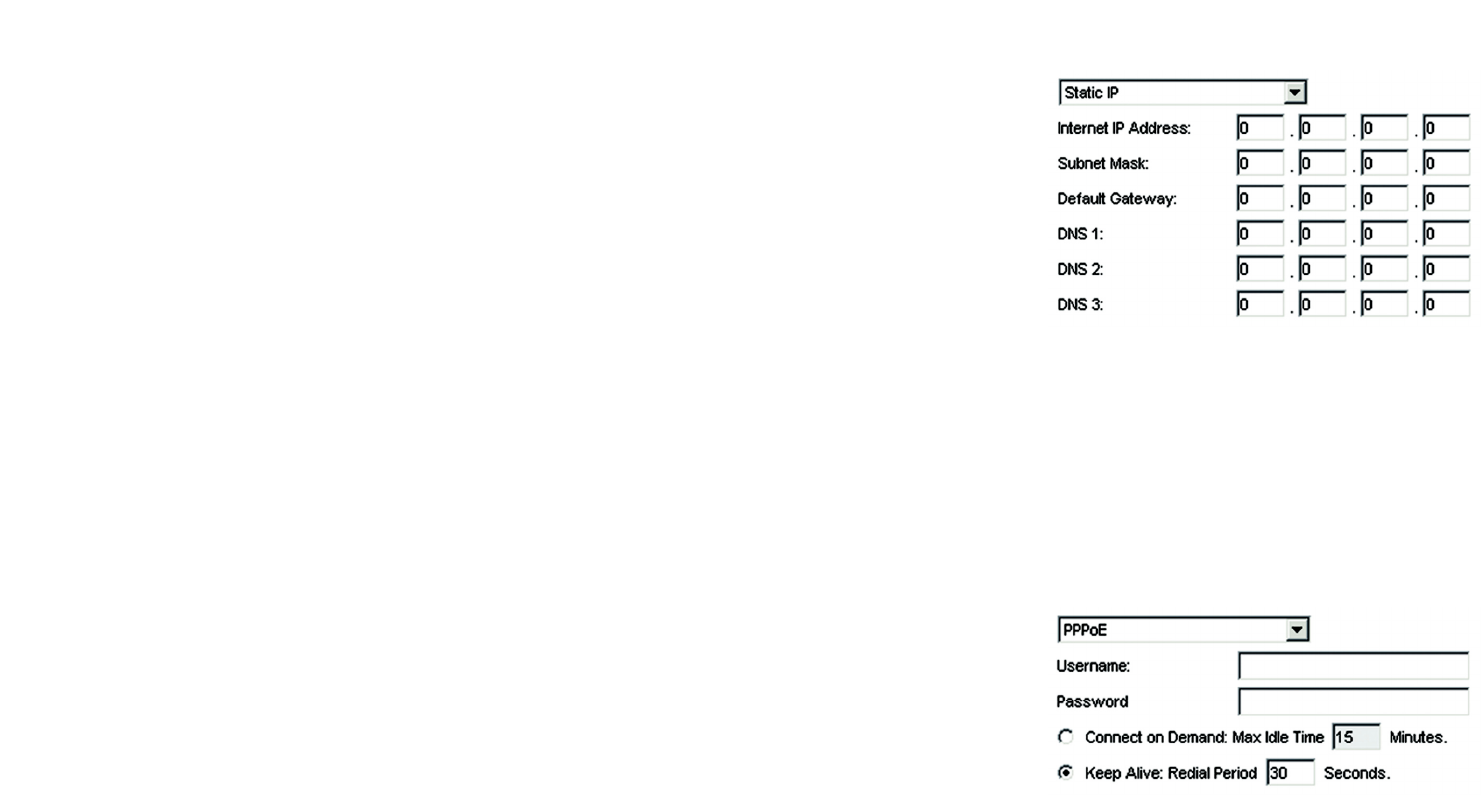
14
Chapter 5: Configuring the Dual-Band Wireless A+G Broadband Router
The Setup Tab - Basic Setup
Dual-Band Wireless A+G Broadband Router
•Static IP. If you are required to use a permanent IP address to connect to the Internet, select Static IP.
Internet IP Address. This is the Router’s IP address, when seen from the Internet. Your ISP will provide you
with the IP Address you need to specify here.
Subnet Mask. This is the Router’s Subnet Mask, as seen by users on the Internet (including your ISP). Your ISP
will provide you with the Subnet Mask.
Default Gateway. Your ISP will provide you with the Gateway Address, which is the ISP server’s IP address.
DNS (1-3). Your ISP will provide you with at least one DNS (Domain Name System) Server IP Address.
•PPPoE. Some DSL-based ISPs use PPPoE (Point-to-Point Protocol over Ethernet) to establish Internet
connections. If you are connected to the Internet through a DSL line, check with your ISP to see if they use
PPPoE. If they do, you will have to enable PPPoE.
User Name and Password. Enter the User Name and Password provided by your ISP.
Connect on Demand: Max Idle Time. You can configure the Router to cut the Internet connection after it has
been inactive for a specified period of time (Max Idle Time). If your Internet connection has been terminated
due to inactivity, Connect on Demand enables the Router to automatically re-establish your connection as
soon as you attempt to access the Internet again. If you wish to activate Connect on Demand, click the radio
button. In the Max Idle Time field, enter the number of minutes you want to have elapsed before your Internet
connection terminates.
Keep Alive Option: Redial Period. If you select this option, the Router will periodically check your Internet
connection. If you are disconnected, then the Router will automatically re-establish your connection. To use
this option, click the radio button next to Keep Alive. In the Redial Period field, you specify how often you want
the Router to check the Internet connection. The default Redial Period is 30 seconds.
Optional Settings
Some of these settings may be required by your ISP. Verify with your ISP before making any changes.
Host Name and Domain Name. These fields allow you to supply a host and domain name for the Router. Some
ISPs, usually cable ISPs, require these names as identification. You may have to check with your ISP to see if your
broadband Internet service has been configured with a host and domain name. In most cases, leaving these
fields blank will work.
MTU. MTU is the Maximum Transmission Unit. It specifies the largest packet size permitted for Internet
transmission. Select Manual if you want to manually enter the largest packet size that will be transmitted. The
Figure 5-5: PPPoE Connection Type
Figure 5-4: Static IP Connection Type
static ip address: a fixed address
assigned to a computer or device
connected to a network.
subnet mask: an address code that
determines the size of the network.
default gateway: a device that forwards
Internet traffic from your local area network.
pppoe: a type of broadband connection that
provides authentication (username and
password) in addition to data transport
packet: a unit of data sent over a network

15
Chapter 5: Configuring the Dual-Band Wireless A+G Broadband Router
The Setup Tab - Basic Setup
Dual-Band Wireless A+G Broadband Router
recommended size, entered in the Size field, is 1500. You should leave this value in the 1200 to 1500 range. To
have the Router select the best MTU for your Internet connection, keep the default setting, Auto.
Network Setup
The Network Setup section changes the Router’s local network settings. Changes to the Router’s wireless
network settings are performed through the Wireless tab.
Router IP
IP Address and Subnet Mask. This shows both the Router’s IP Address and Subnet Mask, as seen by your
network. The default IP Address is 192.168.1.1, and the default Subnet Mask is 255.255.255.0. In most cases,
keeping the default values will work.
DHCP Server Settings
The settings allow you to configure the Router’s Dynamic Host Configuration Protocol (DHCP) server function. The
Router can be used as a DHCP server for your network. A DHCP server automatically assigns an IP address to
each computer on your network. If you choose to enable the Router’s DHCP server option, you must make sure
there is no other DHCP server on your network.
DHCP Server. DHCP is enabled by factory default. If you already have a DHCP server on your network, or you
don’t want a DHCP server, then select Disabled (no other DHCP features will be available).
Assign Static DHCP. Every time a PC reboots, it is assigned a new local IP address by the Router. If you want a PC
to be assigned the same IP address every time it reboots, then click the Assign Static IP button.
On the Static DHCP Client List screen, enter the static local IP address in the Assign this IP field, and enter the
MAC address of the PC in the To this MAC field. Then click the Enabled checkbox. When you have finished your
entries, click the Save Settings button to save your changes. Click the Cancel Changes button to cancel your
changes. To exit this screen, click the Close button.
If you want to see a list of DHCP clients, click the DHCP Client Table button. On the DHCP Client Table screen, you
will see a list of DHCP clients with the following information: Client Names, Interfaces, IP Addresses, and MAC
Addresses. From the To Sort by drop-down menu, you can sort the table by Client Name, Interface, IP Address, or
MAC Address. If you want to add any of the DHCP clients to the Static DHCP Client List, then click the Save to
Static DHCP Client List checkbox and then click the Save Settings button. Click the Cancel Changes button to
cancel your changes. To view the most up-to-date information, click the Refresh button. To exit this screen, click
the Close button.
Figure 5-6: Static DHCP Client List
Figure 5-7: DHCP Client Table

16
Chapter 5: Configuring the Dual-Band Wireless A+G Broadband Router
The Setup Tab - Basic Setup
Dual-Band Wireless A+G Broadband Router
Start IP Address. Enter a value for the DHCP server to start with when issuing IP addresses. Because the
Router’s default IP address is 192.168.1.1, the Starting IP Address must be 192.168.1.2 or greater, but smaller
than 192.168.1.254. The default Starting IP Address is 192.168.1.100.
Maximum Number of Users. Enter the maximum number of PCs that you want the DHCP server to assign IP
addresses to. This number cannot be greater than 253. The default is 50.
IP Address Range. The range of DHCP addresses is displayed here.
Client Lease Time. The Client Lease Time is the amount of time a network user will be allowed connection to the
Router with their current dynamic IP address. Enter the amount of time, in minutes, that the user will be “leased”
this dynamic IP address. After the time is up, the user will be automatically assigned a new dynamic IP address.
The default is 0 minutes, which means one day.
Static DNS 1-3. The Domain Name System (DNS) is how the Internet translates domain or website names into
Internet addresses or URLs. Your ISP will provide you with at least one DNS Server IP Address. If you wish to use
another, type that IP Address in one of these fields. You can type up to three DNS Server IP Addresses here. The
Router will use these for quicker access to functioning DNS servers.
WINS. The Windows Internet Naming Service (WINS) manages each PC’s interaction with the Internet. If you use
a WINS server, enter that server’s IP Address here. Otherwise, leave this blank.
Time Settings
Change the time zone in which your network functions from this pull-down menu. Click the checkbox if you want
the Router to automatically adjust for daylight savings time.
Change these settings as described here and click the Save Settings button to apply your changes or Cancel
Changes to cancel your changes. Help information is shown on the right-hand side of the screen. For additional
information, click More.
dynamic ip address: a temporary IP
address assigned by a DHCP server.

17
Chapter 5: Configuring the Dual-Band Wireless A+G Broadband Router
The Setup Tab - MAC Address Clone
Dual-Band Wireless A+G Broadband Router
The Setup Tab - MAC Address Clone
A MAC address is a 12-digit code assigned to a unique piece of hardware for identification. Some ISPs will
require you to register a MAC address in order to access the Internet. If you do not wish to re-register the MAC
address with your ISP, you may assign the MAC address you have currently registered with your ISP to the Router
with the MAC Address Clone feature.
MAC Address Clone
Enabled/Disabled. To have the MAC Address cloned, select Enabled from the drop-down menu.
MAC Address. Enter the MAC Address registered with your ISP here.
Clone My PC’s MAC. Clicking this button will clone the MAC address of the PC you are currently using.
Change these settings as described here and click the Save Settings button to apply your changes or Cancel
Changes to cancel your changes. Help information is shown on the right-hand side of the screen. For additional
information, click More.
Figure 5-8: Setup Tab - MAC Address Clone
mac address: the unique address that a
manufacturer assigns to each networking device.
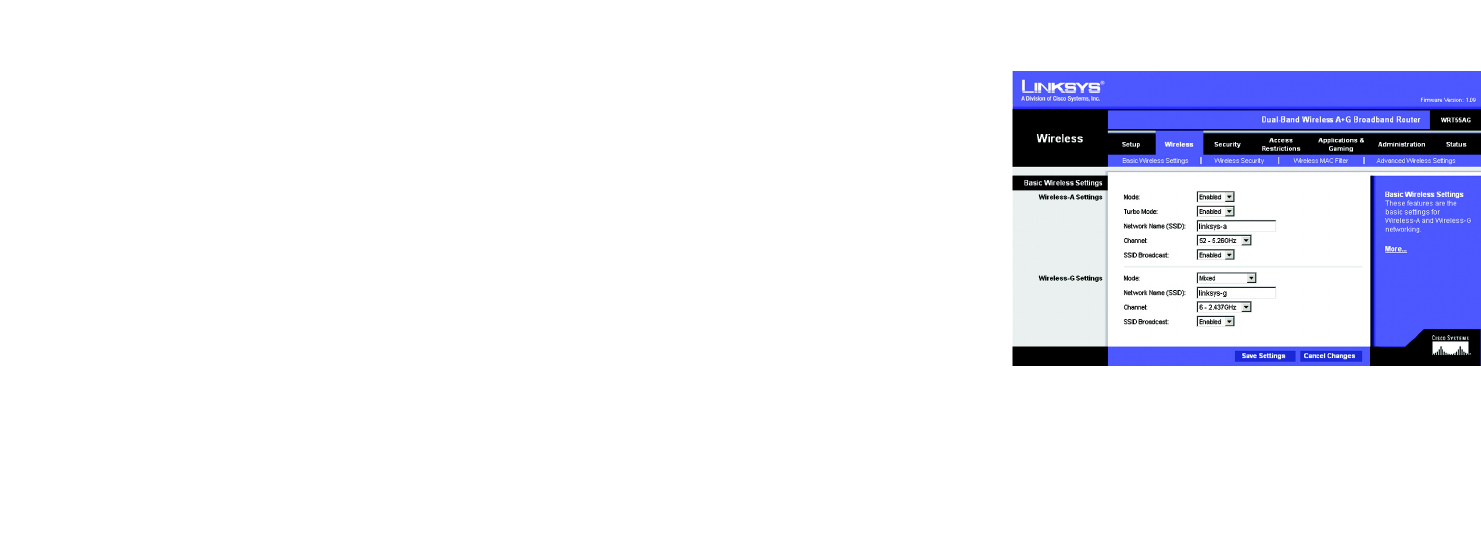
18
Chapter 5: Configuring the Dual-Band Wireless A+G Broadband Router
The Wireless Tab - Basic Wireless Settings
Dual-Band Wireless A+G Broadband Router
The Wireless Tab - Basic Wireless Settings
The basic settings for wireless networking are set on this screen.
Wireless Network
Wireless-A Settings
If you are using a Wireless-A network, then configure these settings.
Mode. To enable Wireless-A (802.11a) networking, select Enabled. Otherwise, select Disabled.
Turbo Mode. Using this mode enables high-speed connections but severely limits range. To function, Turbo Mode
must be enabled on both the Router and wireless PCs. To increase the speed of your wireless transmissions,
select Enabled. (Keep in mind that the Router’s range diminishes in Turbo Mode.) If you do not want to use Figure 5-9: Wireless Tab - Basic Wireless Settings
Turbo Mode, select Disabled.
Network Name (SSID). The SSID is the network name shared by all devices in a wireless network. The SSID
must be identical for all devices in the wireless network. It is case-sensitive and must not exceed 32 keyboard
characters in length. Make sure this setting is the same for all devices in your wireless network. For added
security, you should change the default SSID (linksys-a) to a unique name.
Channel. Select the appropriate channel from the list provided to correspond with your network settings. All
devices in your wireless network must broadcast on the same channel in order to communicate. If you want the
Router to automatically scan for a clear channel, then select Auto (DFS).
SSID Broadcast. When wireless clients survey the local area for wireless networks to associate with, they will
detect the SSID broadcast by the Router. To broadcast the Router's SSID, keep the default setting, Enabled. If you
do not want to broadcast the Router's SSID, then select Disabled.
Wireless-G Settings
If you are using a Wireless-B, Wireless-G, or Wireless B+G network, then configure these settings.
Mode. From this drop-down menu, you can select the wireless standards running on your network. If you have
both 802.11g and 802.11b devices in your network, keep the default setting, Mixed. If you have only 802.11g
devices, select Wireless-G Only. If you have only 802.11b devices, select Wireless-B Only. If you do not have
any 802.11g and 802.11b devices in your network, select Disabled.

19
Chapter 5: Configuring the Dual-Band Wireless A+G Broadband Router
The Wireless Tab - Basic Wireless Settings
Dual-Band Wireless A+G Broadband Router
Network Name (SSID). The SSID is the network name shared by all devices in a wireless network. The SSID
must be identical for all devices in the wireless network. It is case-sensitive and must not exceed 32 keyboard
characters in length. Make sure this setting is the same for all devices in your wireless network. For added
security, you should change the default SSID (linksys-g) to a unique name.
Channel. Select the appropriate channel from the list provided to correspond with your network settings. All
devices in your wireless network must broadcast on the same channel in order to communicate.
SSID Broadcast. When wireless clients survey the local area for wireless networks to associate with, they will
detect the SSID broadcast by the Router. To broadcast the Router's SSID, keep the default setting, Enabled. If you
do not want to broadcast the Router's SSID, then select Disabled.
Change these settings as described here and click the Save Settings button to apply your changes or Cancel
Changes to cancel your changes. Help information is shown on the right-hand side of the screen. For additional
information, click More.
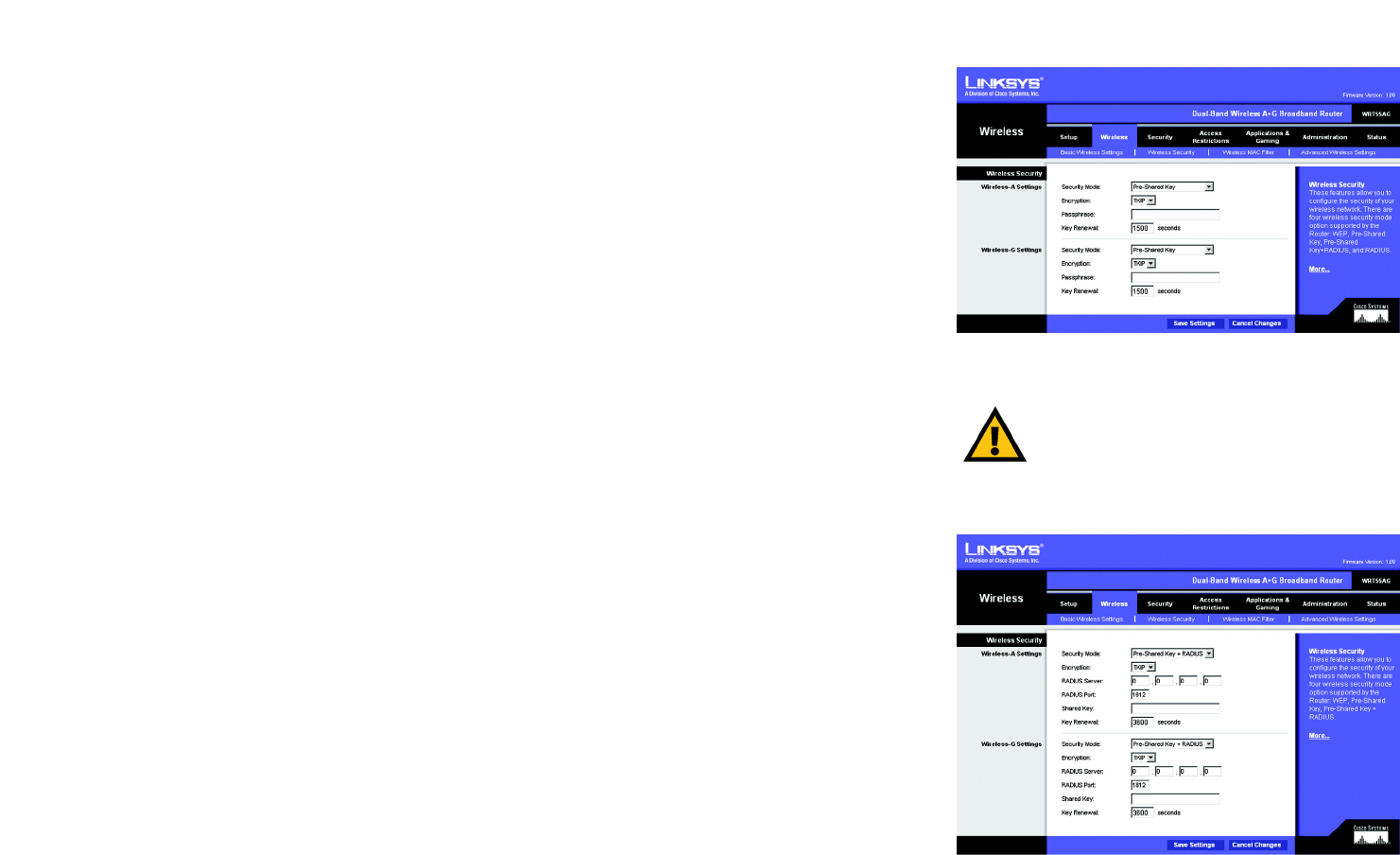
20
Chapter 5: Configuring the Dual-Band Wireless A+G Broadband Router
The Wireless Tab - Wireless Security
Dual-Band Wireless A+G Broadband Router
The Wireless Tab - Wireless Security
The Wireless Security settings configure the security of your wireless network. There are three wireless security
mode options supported by the Router: Pre-Shared Key, Pre-Shared Key + RADIUS, and WEP. (WEP stands for
Wired Equivalent Privacy, while RADIUS stands for Remote Authentication Dial-In User Service.) These three are
briefly discussed here. For detailed instructions on configuring wireless security for the Router, turn to
“Appendix B: Wireless Security.”
Wireless Security
The security options are the same for your Wireless-A and Wireless-G networks. You can use different wireless
security methods for your networks; however, within each network (Wireless-A or Wireless-G), all devices must
use the same security method and settings.
Wireless-A Settings
Pre-Shared Key. This method offers two encryption methods, TKIP and AES, with dynamic encryption keys.
Select the type of encryption method you want to use, TKIP or AES. Enter the Passphrase, which can have 8 to 63
characters. Then enter the Key Renewal period, which instructs the Router how often it should change the
encryption keys.
Pre-Shared Key + RADIUS. This option features a Pre-Shared Key used in coordination with a RADIUS server
that uses either EAP-TLS or PEAP as its authentication method. (This should only be used when a RADIUS server
is connected to the Router.) First, select the type of encryption method you want to use, TKIP or AES. Enter the
RADIUS server’s IP address and port number, along with the authentication key shared by the Router and the
server. Last, enter the Key Renewal period, which instructs the Router how often it should change the encryption
keys.
Figure 5-10: Wireless Tab - Wireless Security
(Pre-Shared Key)
Figure 5-11: Wireless Tab - Wireless Security
(Pre-Shared Key + RADIUS)
radius: a protocol that uses an authentication
server to control network access.
IMPORTANT: If you are using the Pre-Shared Key
or Pre-Shared Key + RADIUS method, always
remember that each device in your wireless
network MUST use the same method and settings,
or else the network will not function properly.

21
Chapter 5: Configuring the Dual-Band Wireless A+G Broadband Router
The Wireless Tab - Wireless Security
Dual-Band Wireless A+G Broadband Router
WEP. WEP is a basic encryption method, which is not as secure as the other two methods, Pre-Shared Key and
Pre-Shared Key + RADIUS. Select a level of WEP encryption, 40/64-bit, 128-bit, or 152-bit. If you want to use a
Passphrase, then enter it in the Passphrase field and click the Generate button. If you want to enter the WEP key
manually, then enter it in the WEP Key 1-4 field(s). To indicate which WEP key to use, select the appropriate TX
Key number.
Wireless-G Settings
Pre-Shared Key. This method offers two encryption methods, TKIP and AES, with dynamic encryption keys.
Select the type of encryption method you want to use, TKIP or AES. Enter the Passphrase, which can have 8 to 63
characters. Then enter the Key Renewal period, which instructs the Router how often it should change the
encryption keys.
Pre-Shared Key + RADIUS. This option features a Pre-Shared Key used in coordination with a RADIUS server
that uses either EAP-TLS or PEAP as its authentication method. (This should only be used when a RADIUS server
is connected to the Router.) First, select the type of encryption method you want to use, TKIP or AES. Enter the
RADIUS server’s IP address and port number, along with the authentication key shared by the Router and the
server. Last, enter the Key Renewal period, which instructs the Router how often it should change the encryption
keys.
WEP. WEP is a basic encryption method, which is not as secure as the other two methods, Pre-Shared Key and
Pre-Shared Key + RADIUS. Select a level of WEP encryption, 40/64-bit or 128-bit. If you want to use a
Passphrase, then enter it in the Passphrase field and click the Generate button. If you want to enter the WEP key
manually, then enter it in the WEP Key 1-4 field(s). To indicate which WEP key to use, select the appropriate TX
Key number.
Change these settings as described here and click the Save Settings button to apply your changes or Cancel
Changes to cancel your changes. Help information is shown on the right-hand side of the screen. For additional
information, click More. For detailed instructions on configuring wireless security for the Router, turn to
“Appendix B: Wireless Security.”
wep (wired equivalent privacy): a method of
encrypting network data transmitted on a
wireless network for greater security.
IMPORTANT: If you are using WEP
encryption, always remember that each
device in your wireless network MUST use
the same WEP encryption method and
encryption key, or else your wireless network
will not function properly.
Figure 5-12: Wireless Tab - Wireless Security (WEP)
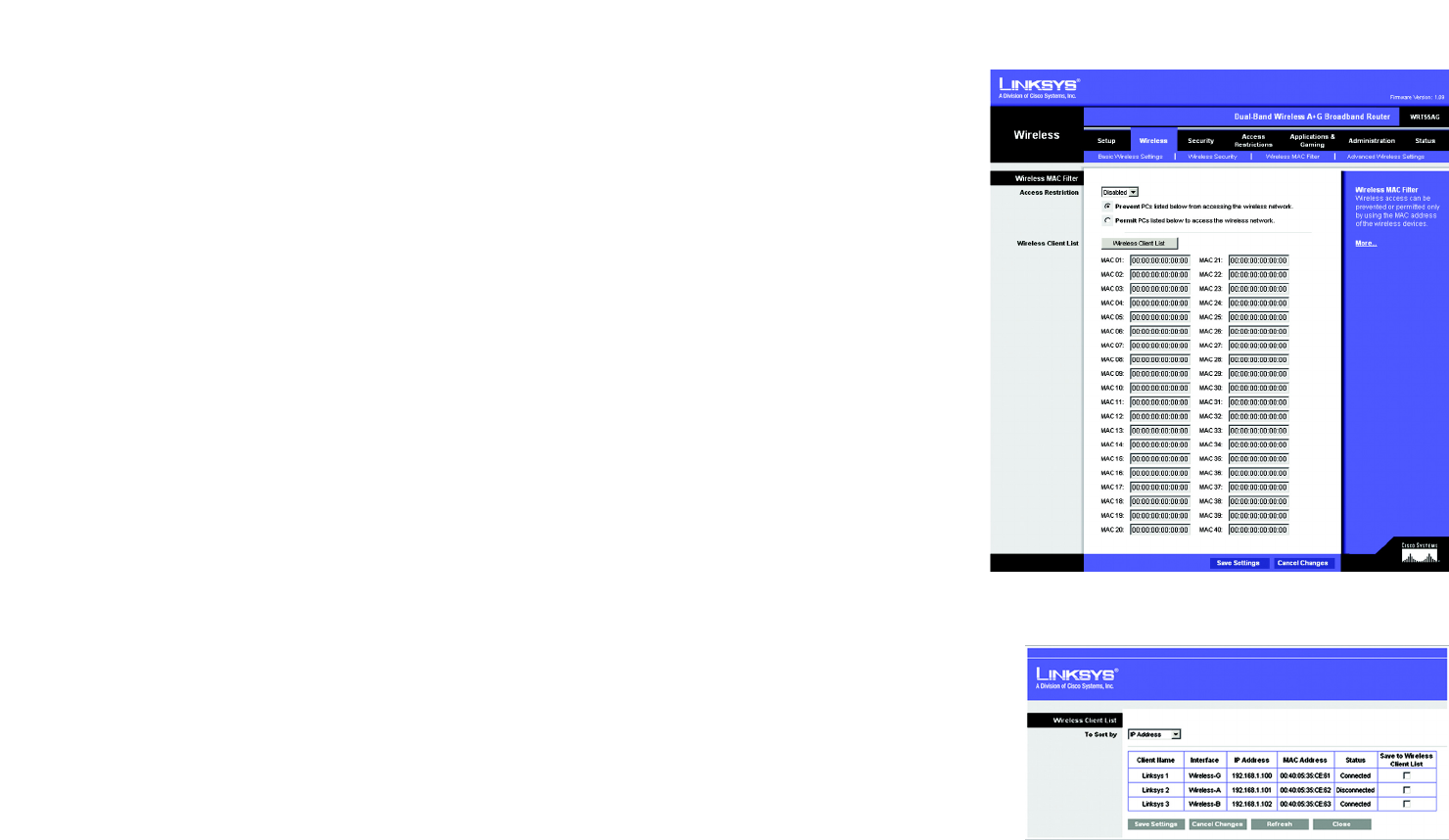
22
Chapter 5: Configuring the Dual-Band Wireless A+G Broadband Router
The Wireless Tab - Wireless MAC Filter
Dual-Band Wireless A+G Broadband Router
The Wireless Tab - Wireless MAC Filter
Wireless access can be filtered by using the MAC addresses of the wireless devices transmitting within your
network’s radius.
Wireless MAC Filter
Access Restrictions
To filter wireless users by MAC Address, either permitting or blocking access, click Enabled. If you do not wish to
filter users by MAC Address, select Disabled.
Prevent PCs listed below from accessing the wireless network. Clicking this radio button will block wireless
access by MAC Address.
Permit PCs listed below to access the wireless network. Clicking this radio button will allow wireless access
by MAC Address.
Wireless Client List
Wireless Client List. Click the Wireless Client MAC List button to display a list of network users by MAC
Address.From the To Sort by drop-down menu, you can sort the table by Client Name, Interface, IP Address, MAC
Address, or Status. If you want to add any of the wireless clients to the Wireless MAC Filter List, then click the
Save to Wireless Client List checkbox and then click the Save Settings button. Click the Cancel Changes
button to cancel your changes. To view the most up-to-date information, click the Refresh button. To exit this
screen, click the Close button.
List users, by MAC Address, whose wireless access you want to control.
Change these settings as described here and click the Save Settings button to apply your changes or Cancel
Changes to cancel your changes. Help information is shown on the right-hand side of the screen. For additional
information, click More.
Figure 5-13: Wireless Tab - Wireless MAC Filter
Figure 5-14: Wireless Client List
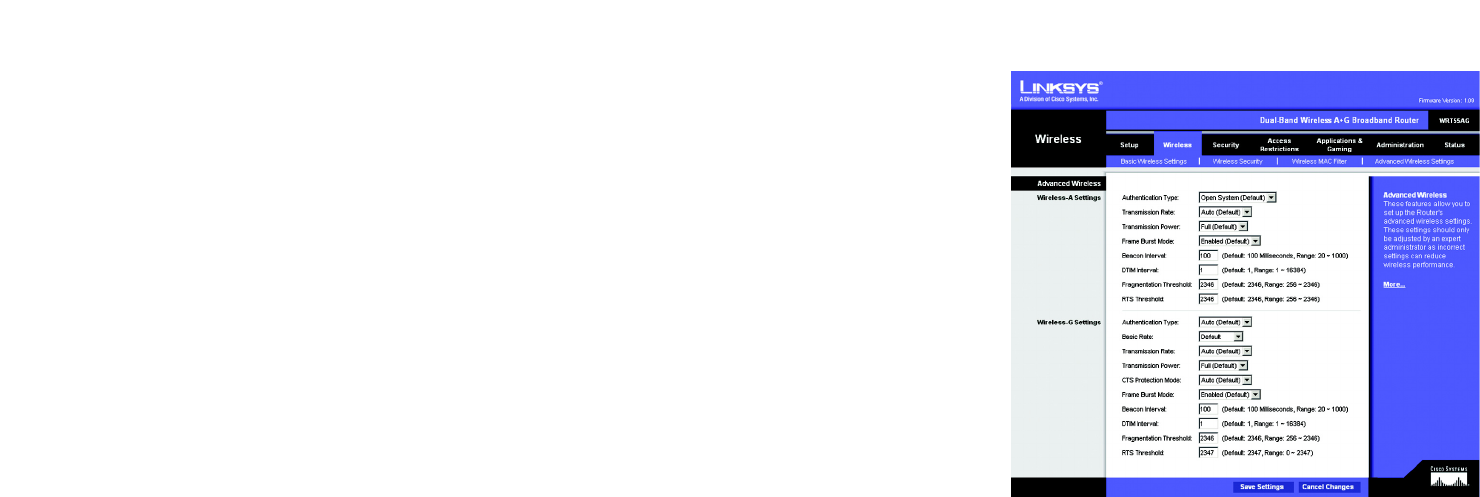
23
Chapter 5: Configuring the Dual-Band Wireless A+G Broadband Router
The Wireless Tab - Advanced Wireless Settings
Dual-Band Wireless A+G Broadband Router
The Wireless Tab - Advanced Wireless Settings
This tab is used to set up the Router’s advanced wireless functions. These settings should only be adjusted by an
expert administrator as incorrect settings can reduce wireless performance.
Advanced Wireless
Wireless-A Settings
Authentication Type. The default is set to Open System (Default) authentication, when the sender and the
recipient do NOT use a WEP key for authentication. With Shared Key authentication, the sender and recipient use
a WEP key for authentication.
Transmission Rate. The rate of data transmission should be set depending on the speed of your wireless
network. You can select from a range of transmission speeds, or you can select Auto (Default) to have the
Router automatically use the fastest possible data rate and enable the Auto-Fallback feature. Auto-Fallback will
negotiate the best possible connection speed between the Router and a wireless client. The default value is Auto
(Default).
Transmission Power. The greater the transmission power used, the larger the area a wireless network covers.
To minimize the likelihood of eavesdropping by unauthorized wireless users, do not use more transmission power
than necessary to cover the range needed by your wireless network. Try using the Router at different levels of
transmission power, and determine how much power is needed to reach the wireless client, such as a PC or
access point, that is farthest from the Router. Then select the appropriate level, Full (Default), Half, Quarter,
Eighth, or Min, from the drop-down menu. The default is Full (Default).
Frame Burst Mode. Enabling this option should provide your network with greater performance, depending on
the manufacturer of your wireless products. If you are not sure how to use this option, keep the default, Enabled
(Default).
Beacon Interval. The default value is 100. The Beacon Interval value indicates the frequency interval of the
beacon. A beacon is a packet broadcast by the Router to synchronize the wireless network.
DTIM Interval. This value indicates the interval of the Delivery Traffic Indication Message (DTIM). A DTIM field is
a countdown field informing clients of the next window for listening to broadcast and multicast messages. When
the Router has buffered broadcast or multicast messages for associated clients, it sends the next DTIM with a
DTIM Interval value. Its clients hear the beacons and awaken to receive the broadcast and multicast messages.
The default value is 1.
Fragmentation Threshold. This value specifies the maximum size for a packet before data is fragmented into
multiple packets. If you experience a high packet error rate, you may slightly increase the Fragmentation
Figure 5-15: Wireless Tab - Advanced Wireless Settings
beacon interval: data transmitted on your wireless
network that keeps the network synchronized.
dtim: a message included in data packets
that can increase wireless efficiency.
fragmentation: breaking a packet into smaller units
when transmitting over a network medium that
cannot support the original size of the packet.

24
Chapter 5: Configuring the Dual-Band Wireless A+G Broadband Router
The Wireless Tab - Advanced Wireless Settings
Dual-Band Wireless A+G Broadband Router
Threshold. Setting the Fragmentation Threshold too low may result in poor network performance. Only minor
reduction of the default value is recommended. In most cases, it should remain at its default value of 2346.
RTS Threshold. Should you encounter inconsistent data flow, only minor reduction of the default value, 2346, is
recommended. If a network packet is smaller than the preset RTS threshold size, the RTS/CTS mechanism will
not be enabled. The Router sends Request to Send (RTS) frames to a particular receiving station and negotiates
the sending of a data frame. After receiving an RTS, the wireless station responds with a Clear to Send (CTS)
frame to acknowledge the right to begin transmission. The RTS Threshold value should remain at its default value
of 2346.
Wireless-G Settings
Authentication Type. The default is set to Auto (Default), allows either Open System or Shared Key
authentication to be used. With Open System authentication, the sender and the recipient do NOT use a WEP key
for authentication. With Shared Key authentication, the sender and recipient use a WEP key for authentication.
Basic Rate. The Basic Rate setting is not actually one rate of transmission but a series of rates at which the
Router can transmit. The Router will advertise its Basic Rate to the other wireless devices in your network, so
they know which rates will be used. The Router will also advertise that it will automatically select the best rate
for transmission. The default setting is Default, when the Router can transmit at all standard wireless rates
(1-2Mbps, 5.5Mbps, 11Mbps, 18Mbps, and 24Mbps). Other options are 1-2Mbps, for use with older wireless
technology, and All, when the Router can transmit at all wireless rates. The Basic Rate is not the actual rate of
data transmission. If you want to specify the Router’s rate of data transmission, configure the Transmission Rate
setting.
Transmission Rate. The rate of data transmission should be set depending on the speed of your wireless
network. You can select from a range of transmission speeds, or you can select Auto (Default) to have the
Router automatically use the fastest possible data rate and enable the Auto-Fallback feature. Auto-Fallback will
negotiate the best possible connection speed between the Router and a wireless client. The default value is Auto
(Default).
Transmission Power. The greater the transmission power used, the larger the area a wireless network covers.
To minimize the likelihood of eavesdropping by unauthorized wireless users, do not use more transmission power
than necessary to cover the range needed by your wireless network. Try using the Router at different levels of
transmission power, and determine how much power is needed to reach the wireless client, such as a PC or
access point, that is farthest from the Router. Then select the appropriate level, Full (Default), Half, Quarter,
Eighth, or Min, from the drop-down menu. The default is Full (Default).
CTS Protection Mode. CTS (Clear-To-Send) Protection Mode should be set to Auto (Default). The Router will
automatically use CTS Protection Mode when your Wireless-G products are experiencing severe problems and
are not able to transmit to the Router in an environment with heavy 802.11b traffic. This function boosts the
cts (clear to send): a signal sent by a wireless
device, signifying that it is ready to receive data.